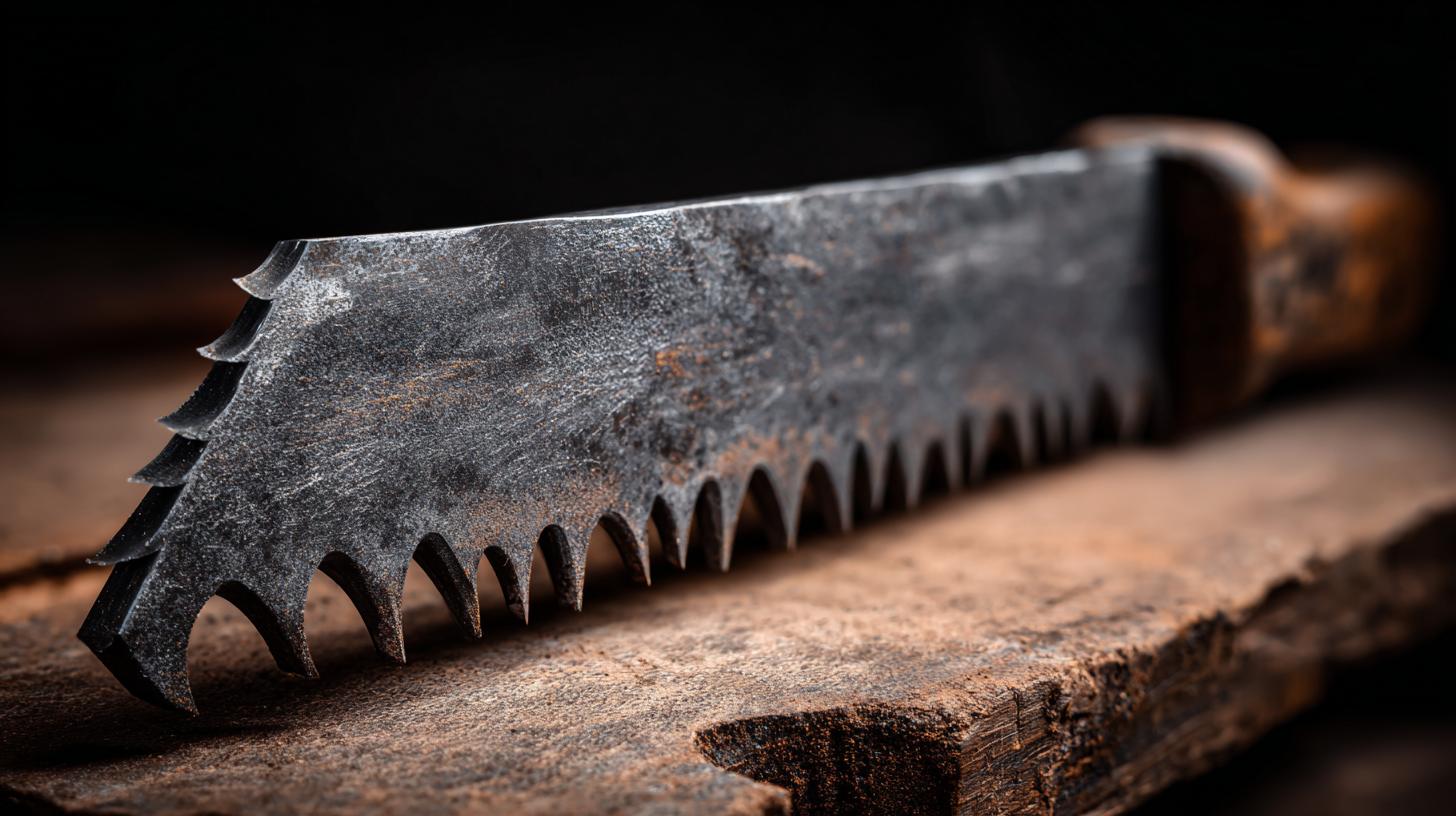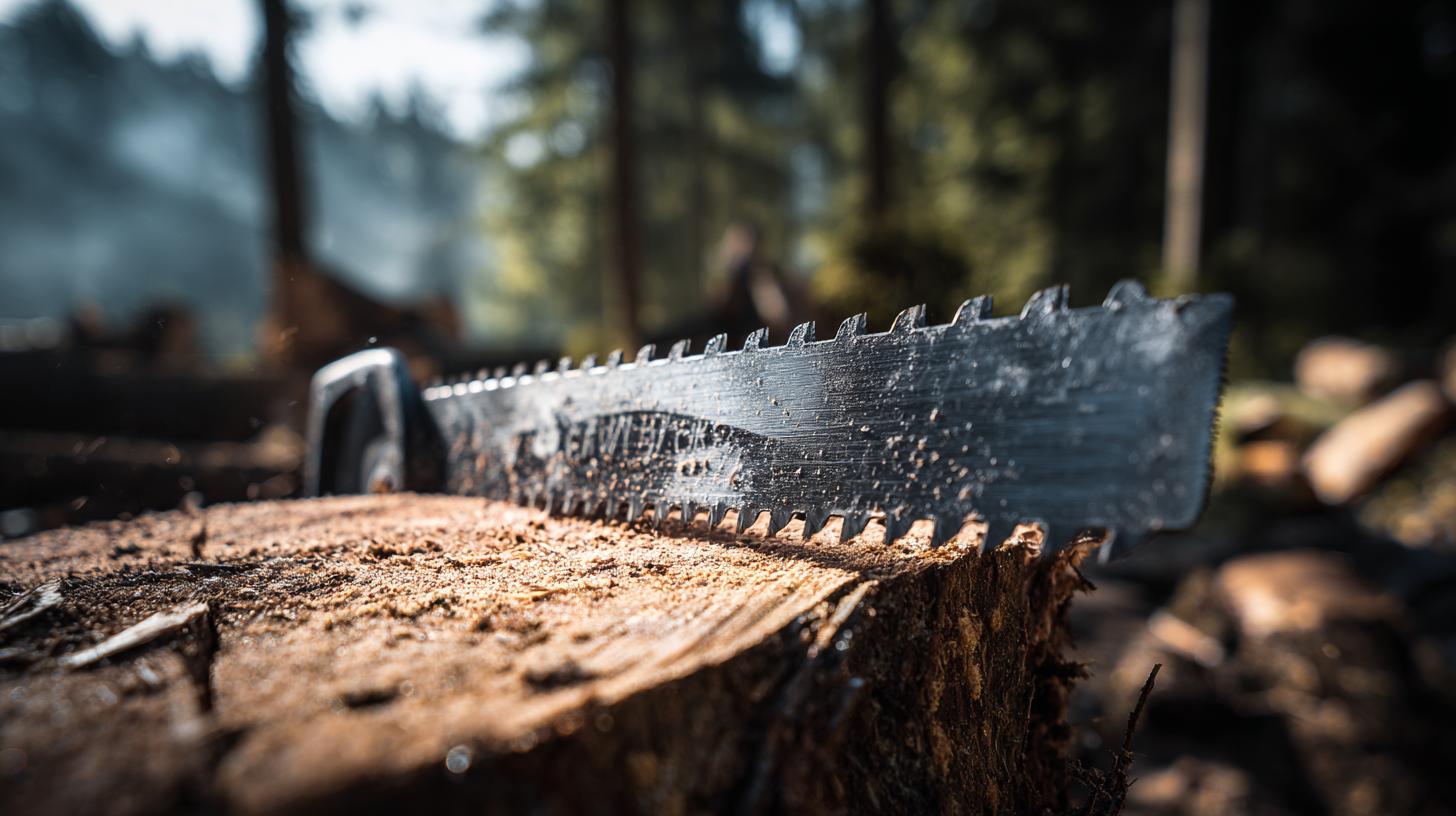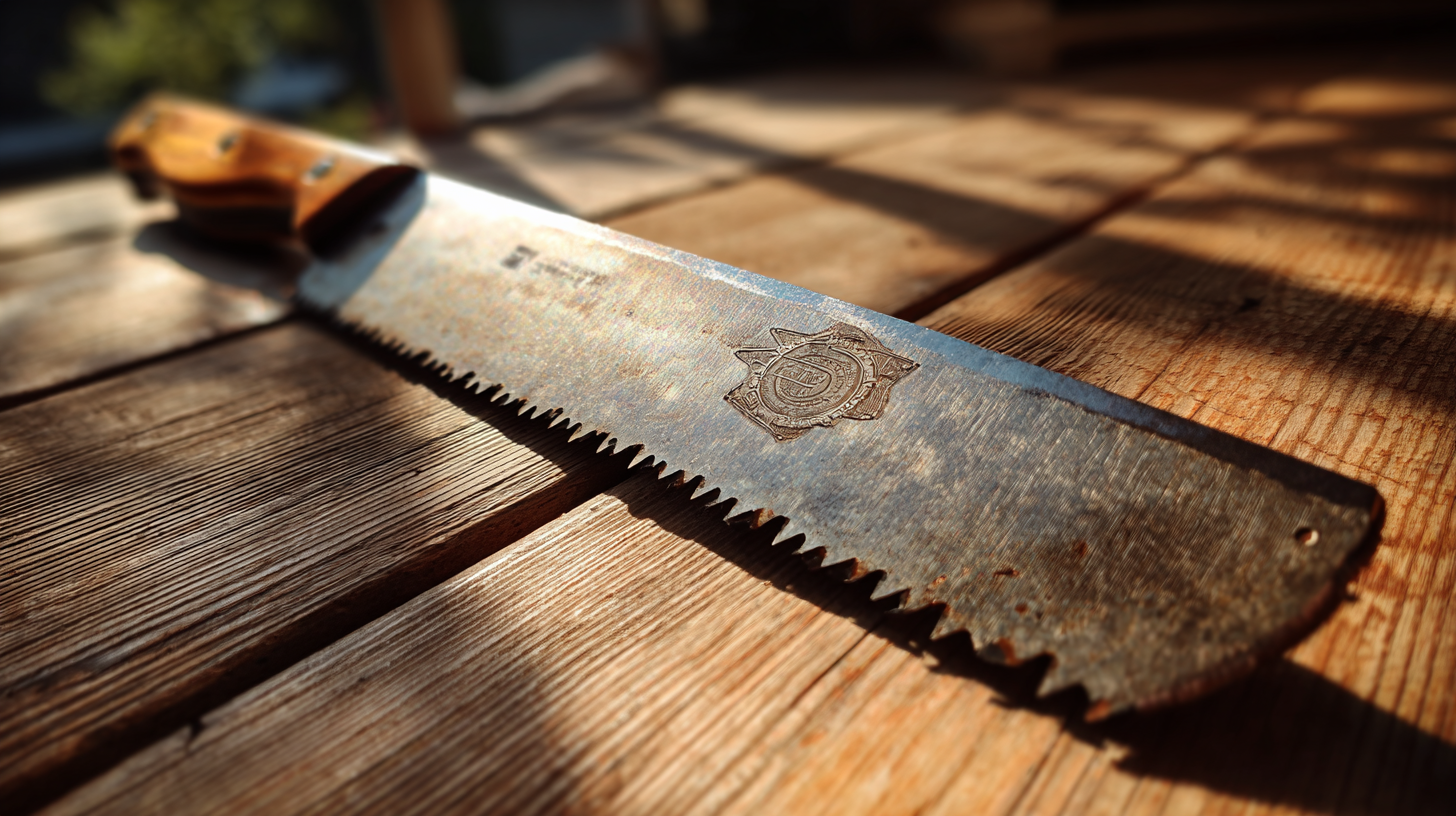Exploring Unique Alternatives to 18 Sawzall Blade for Your Cutting Needs
Table of Contents
- Alternative Blade Options for Specialized Cutting Jobs
- Understanding Material Compatibility for Optimal Performance
- Tips for Choosing the Right Blade Length for Your Project
- Innovative Cutting Techniques to Maximize Efficiency
- Maintenance Tips for Prolonging the Life of Your Sawzall Blades
- Safety Guidelines for Using Alternative Sawzall Blades
- Maximize Your Cutting Efficiency: The Essential Guide to T118B Cheap Bulk Sawzall Blades for Every DIYer
- FAQS
- Conclusion
- Related Posts
In today’s ever-changing world of power tools, it’s never been more important to have reliable, high-quality cutting solutions. According to a report by Grand View Research, the global power tools market is expected to hit around USD 42 billion by 2026 — thanks largely to the uptick in construction and renovation projects everywhere. One key accessory in this space is the 18 Sawzall Blade, which folks love for its versatility—whether you're dealing with wood, metal, or other materials, it’s a real workhorse. Wenzhou Yichuan Tools Co., Ltd., started back in 2003, has really made a name for itself as a leader in making electric tool accessories, especially top-notch saw blades for everyone—from pros to DIYers. As we dive into some cool alternatives to the standard 18 Sawzall Blade, you’ll see there are some innovative options out there that can seriously up your cutting game. It’s all about showing how our focus on quality can help make your cutting projects smoother and more efficient.

Alternative Blade Options for Specialized Cutting Jobs
When you're tackling specialized cutting jobs, picking the right blade can really make a difference in how quick and well you get things done. Sure, the trusty old Sawzall blade is a solid choice, but there are other blades out there tailored for specific tasks that can actually give you better results. For example, oscillating tool blades are catching on because they’re so versatile—they can handle cutting, sanding, even drilling. These are perfect if you’re working on tricky stuff like trimming pipes or doing detailed designs, where precision is key and standard blades just don’t cut it.
Then there’s the option of specialized table saw blades, designed for particular materials or cutting styles. Need to make fine, smooth cuts in plywood? Or maybe rip through hardwood? Having the right blade can save you a ton of time and leave your cuts looking clean as hell. Plus, don’t forget utility knives—they’re great for everyday tasks and come in handy more often than you’d think. Bottom line: choosing the right tool for the job means you’ll get better results and make your work a lot easier, instead of just sticking to the usual stuff just because it’s familiar.
Alternative Blade Options for Specialized Cutting Jobs
This chart illustrates various alternatives to standard sawzall blades based on their cutting applications and material compatibility. Each blade type showcases its effectiveness in handling different materials, allowing users to select the most suitable option for their specific cutting needs.
Understanding Material Compatibility for Optimal Performance
When you're choosing sawzall blades, it's super important to get a handle on what materials you're working with. Knowing this can really give you an edge when it comes to cutting efficiently. For example, blades made for wood usually have bigger, spaced-out teeth that cut pretty quickly—easy peasy.
On the flip side, metal blades tend to have finer teeth and are often crafted from bi-metal to last longer. So, figuring out what you're cutting helps you pick the right blade, which means better performance and your tool will thank you by lasting longer.
Also, don’t forget to think about how thick or dense your material is. Soft woods? A regular wood blade should do just fine. But if you’re tackling hardwood or composite materials, you might want to go for something a little tougher, like a high-speed steel or carbide-tipped blade. And when it’s metal? Specialized blades designed for stainless steel or aluminum can make all the difference. Basically, matching your blade to the material not only gets you cleaner cuts but also helps avoid damaging your blade—that’s a win-win for smoother, more controlled cuts all around.
Tips for Choosing the Right Blade Length for Your Project
When you're trying to pick the right Sawzall blade for your cutting projects, there's one key thing you really want to keep in mind: blade length. These blades usually range from about 6 inches up to 12 inches, and choosing the right size can make a big difference in how smooth and quick your cuts are. I read a report from the Power Tool Institute that said longer blades are great for deep cuts and can handle thicker stuff—perfect if you're doing demolition work or working with large pieces of wood. On the other hand, shorter blades give you better control and are ideal for tricky jobs like plumbing or electrical work where precision matters more.
A few tips to help you pick the right blade length:
1. Think about the material: If you're cutting through heavy-duty stuff like metal or thick lumber, go for a longer blade—say, a 12-inch one. But if it’s a smaller, everyday project, a 6-inch blade might do the trick.
2. Look at your project: Are you working in tight spaces or making detailed, intricate cuts? Shorter blades are more manageable there. Planning on making long, straight cuts? A longer blade will probably get those done faster and easier.
Getting a good handle on how blade length affects your work can really help you get better results and make your cutting tasks a lot more manageable. It’s all about matching the right blade to what you’re trying to accomplish!

Innovative Cutting Techniques to Maximize Efficiency
When it comes to cutting tools, efficiency really matters, right? Sure, Sawzall blades are super popular because they’re so versatile, but sometimes, trying out different cutting methods can really give your workflow a boost. For example, oscillating multi-tools are great for getting precise cuts in tight spots where those bulky blades just don’t cut it. They’re especially handy for things like drywall or home repairs — you get cleaner edges, and it cuts down on the sanding afterward.
And here’s another cool option: plasma cutters for metalwork. They’re pretty awesome because they’re fast, efficient, and they tend to cause less heat distortion than your typical cuts. Whether you’re working on a big industrial project or just fiddling around with DIY stuff, plasma cutters let you make detailed designs or cut through thicker metal with relative ease. Exploring these alternatives can really help you get more done and improve the quality of your cuts. Honestly, it just makes working on projects way more enjoyable and less of a hassle.
Exploring Unique Alternatives to 18 Sawzall Blade for Your Cutting Needs
| Alternative Blade Type | Material | Best Use Case | Cutting Speed (in/min) | Durability Rating (hrs) |
|---|---|---|---|---|
| Bi-Metal Blade | High-Speed Steel with Cobalt | General Purpose Cutting | 200 | 50 |
| Carbide Tipped Blade | Carbide | Hard Materials like Metal | 180 | 75 |
| Diamond Blade | Diamond-Coated | Concrete, Masonry | 150 | 100 |
| Wood Cutting Blade | High Carbon Steel | Wood and Plastic | 300 | 40 |
| Multi-Purpose Blade | Composite Material | Varied Materials | 220 | 60 |
Maintenance Tips for Prolonging the Life of Your Sawzall Blades
Taking good care of your Sawzall blades is really the secret to making them last longer and work better. A simple but often overlooked tip? Make sure to wipe down your blades after you're done using them. Those little bits of wood sap or metal shavings can build up and cause rust, which saps the blades' cutting power. Just grabbing a cloth or soft brush and giving them a quick clean can make a big difference—it helps prevent corrosion and keeps your blades in top shape.
Also, it’s a good idea to check your blades regularly. Keep an eye out for dull teeth or tiny cracks—these are signs that it's probably time to sharpen or swap out the blade. Nobody wants to deal with inefficient cuts or worse, injuring themselves! And don’t forget about storage—storing your blades in a dry, organized spot not only keeps them safe from damage but also makes them easy to grab when you’ve got a project coming up. Stick to these simple tips, and you'll get a smoother cutting experience—and save some cash in the long run, too.

Safety Guidelines for Using Alternative Sawzall Blades
When you're checking out different Sawzall blades for your cutting projects, safety should always be at the top of your list. I mean, according to OSHA, mishandling power tools causes thousands of injuries every single year. So, it’s super important to follow safety tips—like, always throw on your safety glasses, gloves, and hearing protection. Also, make sure your workspace is nice and tidy—no clutter that could trip you up or cause accidents during your cuts.
Here's a little tip: Before you start with any alternative blade, take a moment to get familiar with the material you’re about to cut. Pick a blade that’s made for that specific job. For example, carbide-tipped blades are great for hitting tough materials, while bi-metal blades are pretty much a jack of all trades. Oh, and don’t forget to check your blades for any wear or damage before you use them—just a quick peek can save you trouble down the line.
And yeah, make sure your Sawzall itself is in good shape. Follow the manufacturer’s instructions for installing and running blades—regular maintenance isn’t just a bore, it actually helps prevent your tool from acting up. Staying on top of this stuff not only keeps you safe but also helps you get better results and saves time, too.
Here's another tip: clamp down whatever you’re working on. It might seem obvious, but it really makes a difference—more control, fewer surprises, and less risk of kickback or the blade getting jammed.
Maximize Your Cutting Efficiency: The Essential Guide to T118B Cheap Bulk Sawzall Blades for Every DIYer
When it comes to DIY projects, having the right tools can make all the difference in achieving precision and efficiency. One tool that stands out for its versatility and power is the jigsaw, and the T118B 3-inch 14-tooth jig saw blades are a must-have for any DIYer looking to maximize their cutting efficiency. These blades are designed with a Bosch-style tang shank (T shank) that eliminates the common set screw mounting hole, which is often a weak spot prone to breaking. By opting for T118B blades, you’re investing in a more durable option that allows for smooth, uninterrupted cutting.
Not only do these blades boast enhanced durability, but they are also incredibly easy to use. The T shank design ensures a secure fit in a wide range of jigsaw models, allowing for quick changes between different projects. Whether you’re cutting through wood, plastic, or even metal, the 14-tooth configuration provides a clean and precise cut, making them suitable for both intricate designs and straight cuts. By incorporating T118B blades into your toolkit, you’ll find that your cutting tasks become much more manageable and efficient, empowering you to tackle any DIY project with confidence.
FAQS
: Alternative blade options include oscillating tool blades for versatile cuts, specialized table saw blades for specific materials, and various utility knife options for everyday tasks.
Oscillating tool blades are popular due to their versatility, allowing for cutting, sanding, and drilling, and are ideal for intricate tasks like trimming pipes or crafting detailed designs.
Material compatibility is crucial as different materials require specific blade designs; for example, wood blades have larger teeth for fast cutting, while metal blades have finer teeth for durability.
The thickness and density of the material determine blade choice; softer woods may require standard wood blades, while hardwood or composites might need high-speed steel or carbide-tipped blades.
Innovative techniques include using oscillating multi-tools for precise cuts in tight spaces and plasma cutters for fast, efficient metalwork with less heat distortion.
Plasma cutters provide a fast and efficient method for cutting with reduced heat distortion, making them ideal for industrial applications and intricate DIY projects.
Specialized table saw blades are designed for specific materials and cutting styles, providing clean cuts for tasks like fine woodworking in plywood or ripping through hardwood efficiently.
Selecting the right tools ensures better efficiency, cleaner results, and reduced wear on the tools, ultimately leading to smoother and more controlled cutting operations.
Conclusion
In our article, "Exploring Unique Alternatives to 18 Sawzall Blades for Your Cutting Needs," we take a close look at a bunch of different blade options that are perfect for more specialized cutting jobs. Knowing what material you're working with is super important — it helps you pick the right blade for best results. We also share some handy tips on choosing the right blade length, which can really make your cutting job smoother and faster, no matter what you're tackling.
Plus, we talk about some cool cutting techniques that can help you get more done in less time. We also cover basic maintenance tips to help keep your Sawzall blades in top shape and last longer. And of course, safety is a big deal, so we've included some important guidelines to keep you safe when using these alternative blades.
Since Wenzhou Yichuan Tools Co., Ltd. keeps coming out with high-quality electric tool accessories, we hope this blog becomes a great resource — whether you're a pro or just a DIY enthusiast — to make your cutting projects easier and more efficient.
Related Posts
-

What is the Best Reciprocating Saw Pruning Blade for Efficient Tree Maintenance
-

Discover the Most Reliable Fine Hacksaw Blade Examples for Your Next Project
-

Global Buyers Discover the Excellence of 18 Inch Reciprocating Saw Blades from a Leading Chinese Manufacturer
-

5 Essential Reasons to Choose the Best Blades For A Jigsaw
-

China Manufacturing Thrives Amid US China Tariff Challenges with Best Sawzall Blade Insights
-

The Ultimate Guide to Choosing the Best Long Blade for Jigsaw Comparing Performance Durability and Precision
Blog Tags:





